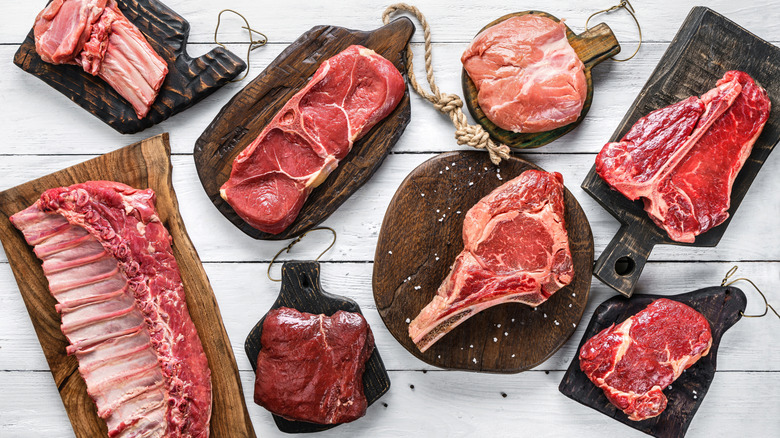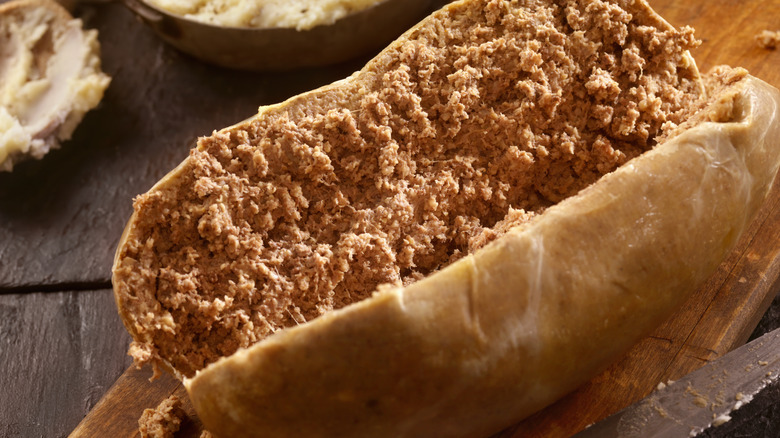13 Meats That Are Now Illegal In The US
The U.S. is a carnivorous country that consumes the second-most meat per capita in the world. Chicken is most popular, followed by beef and pork to round out the top three. Fish is also prominent, with shrimp being the most popular seafood. That doesn't mean everything is fair game though. While adventurous eaters can legally sample wild meats like alligator, rattlesnake, and venison, there are several meats that used to be consumed in the United States that can land you in legal trouble now.
Some meats are banned by wildlife conservation laws. Others are banned by laws focused on the health and safety of the American public. The authority to determine legality resides with Congress and the most impactful bans have required legislation from its chambers. Enforcement is handled by a complex network of overlapping regulations enforced by multiple agencies.
Some of the most critical protections are provided by the Endangered Species Act that protects the worlds most vulnerable species. Other meats are banned by agencies such as the Center for Disease Control (CDC) to prevent foodborne illnesses from entering the country. However, these laws are specific to the United States and some of the meats are available in other countries, though you would still have to grapple with the ethical and safety concerns that prompted the ban before ordering them.
1. Sea turtle meat
Turtle soup doesn't top many lists of favorite foods these days, but it was once a popular dish enjoyed by high society. Fans included several former American presidents including Howard Taft, who held the office from 1909 to 1913. He enjoyed it so much that he employed a special chef just to make the signature dish. Campbell's even sold a canned version to satisfy the high public demand.
The soup was often made from the sea turtles found in American waters. While the ocean cruisers are widely revered by Americans now, they were historically appreciated for their meat rather than beauty. Widespread fishing led to a significant decline in the population and led to their inclusion in the Endangered Species Act of 1973. Despite it being a crime to eat sea turtle meat, all six species that visit American waters remain endangered and face significant challenges.
However, that wasn't the end of turtle soup, which is perfectly legal as long as it doesn't contain sea turtle. It is served in many New Orleans eateries, including Galatoire's, who have had it on the menu since the grand opening in 1905. Today's soup is made from farm-raised snapping turtles, and the meat has a flavor and texture that falls between chicken and veal.
2. Owl meat
Owls were never a primary food source in America, but they did supplement the diet of early citizens. One of the earliest records of owl consumption comes from John James Audubon who published "Birds of America" as a series between 1827 and 1839. In it, he wrote: "The Barred Owl is very often exposed for sale in the New Orleans market. The Creoles make gumbo of it, and pronounce the flesh palatable."
While beer might be a popular gumbo addition, you won't find owls these days thanks to the Migratory Bird Treaty Act of 1918. This landmark piece of legislation was one of the nation's first conservation laws. It was championed by Senator George P. McLean who used his first speech in Congress to push for bird conservation. "We must use every effort to secure the support of the public until the birds of America are saved," he told the chamber. It was a precipice time for American bird populations who were hunted for their feathers as well as their meat.
Today, more than 1,000 species of birds are protected by the act, including owls. The bill makes it illegal to hunt, capture, or kill any bird protected by the act. In fact, even possessing a feather from one of the protected birds is illegal. Thanks in large part to these protections, the barred owl has a stable population and can be found throughout most of North America.
3. Dog meat
Americans tend to see dogs as friends and companions instead of food. However, consumption used to be legal, and the animals were eaten during challenging times. One notable example is Lewis and Clark's famed expedition. Meriwether Lewis recorded in his journal: "The dog now constitutes a considerable part of our subsistence and with most of the party has become a favorite food ... from habit it has become by no means disagreeable to me, I prefer it to lean venison or Elk, and is very far superior to the horse in any state."
Dog meat is consumed in other parts of the world including China, Vietnam, and South Korea. There is a controversial dog meat festival that takes place annually in Yulin, China. Despite hosting the festival, consuming dog meat is not as commonplace as you might expect with 87.5% of the residents reporting that they rarely or never eat it, according to a survey from Humane World for Animals.
Eating dogs was technically legal in the U.S. until Congress passed the Dog and Cat Meat Trade Prohibition Act in 2018. Prior to this, it was not a federal crime to consume dog meat. However, your furry friends had nothing to worry about as prior to the law's passage there was already a network of laws in place preventing a dog meat market in America.
4. Wild beluga caviar
Caviar (salt-cured fish eggs from sturgeon) is wildly-popular with the French, who lead the world in consumption. At least it is wildly-popular among the crowd that can afford the high price tag for the luxury item. Caviar has a rich, salty, and briny flavor and is traditionally paired with accoutrements such as crème fraîche, blinis, and hard boiled egg. Recently, there has been a trend to serve it in a more playful style, such as paired with Doritos.
What you won't find on menus is wild beluga sturgeon, which has been banned for importation since 2005. Beluga sturgeon are ancient fish that originated in the Mesozoic period. Tragically, they experienced a 90% population decline between 1985 and 2005. Since Americans were the primary consumers of beluga caviar, eliminating the market was a critical step in preserving the species.
While importation is illegal, there is a single Florida-based provider that obtained the only existing permit to trade in beluga. Their farm-raised product is available for those who must try eggs from the critically endangered species of fish. It is sold in limited locations, including a Hollywood lounge that has it on the menu at $1,100 for an ounce.
5. Robin meat
Most Americans recognize the robin as an attractive songbird that is ubiquitous across North America, but our forefathers saw it as a tasty treat. New York based butcher Thomas F. DeVoe wrote a comprehensive market guide in 1867 in which he recorded: "large numbers of robins are found in our markets, and thousands are also shot by sportsmen in the months of September and October, when they are fat and delicate eating."
A popular preparation was to bake them into a robin pie. "Weman's Cookbook," published in 1890, included a recipe: "Cover the bottom of a pie-dish with thin slices of beef and fat bacon, over which lay ten or twelve robins, previously rolled in flour, stuffed as above, season with a teaspoonful of salt, a quarter ditto of pepper, one of chopped parsley, and one of chopped eschalots, lay a bay-leaf over, add a gill of broth, and cover with three quarters of a pound of half puff taste, bake one hour in a moderate oven, shake well to make the gravy in the pie form a kind of sauce, and serve quite hot."
Robins have been off the menu since the passage of the Migratory Bird Treat Act. Without fear of being a pie filling the population has thrived and the Cornell Lab of Ornithology currently estimates there are more robins than humans in America. While many species are struggling, the robin is a welcome success story and they experienced steady population growth between 1966 and 2019.
6. Ortolan meat
The ortolan bunting is a small migratory songbird that can be found across the European continent. It's also the primary ingredient in a traditional French culinary experience that many find bizarre. The preparation requires the bird to be fattened, then simultaneously drowned and marinated in Armagnac brandy before being plucked and roasted. It's served to diners with napkins draped over their heads who consume the bird whole, including the bones. Ostensibly, the napkin is meant to trap the savory aromas, but some claim it is to hide the shameful act from God.
Ortolan made appearances on early American fine-dining and banquet menus. However, it's unlikely that American chefs had access to the European songbird. It's more reasonable that they typically mimicked the technique but used a native bird.
It's not a dish you will find on American or European menus anymore. The controversial practice contributed to an 88% decline in the ortolan bunting population, leading to bans in both the European Union and the United States. France was the last to join the ban, but you won't even find it on French menus anymore. The prevailing sentiment is that it is a recipe better suited for history books than cookbooks.
7. Horse meat
Horse meat has never been a preferred source of protein in America but it is eaten in countries such as France, the Netherlands, Belgium, and Italy. Advocates point out it's a red meat that contrasts favorably with beef. Nutritionally, it is lower in fat and cholesterol and has four times the amount of iron. Horses also emit five times less methane into the atmosphere and could be more beneficial for the climate.
Those arguments fell on deaf ears in the United States. While eating a horse is not a federal crime, Congress outlawed selling the meat and effectively eliminated it from American butcher chops. In addition, several states have passed laws banning consumption altogether.
Despite laws preventing a domestic market, American slaughterhouses continued to sell horse meat to foreign countries until 2007. Congress eliminated the practice by defunding inspections. Without inspections the meat could not be sold, and it ended the practice. American slaughterhouses no longer process horse meat for human consumption.
8. Haggis
Haggis is the national dish of Scotland, but you won't find it in the menus of American diners. That's because it is an offal-based pudding, which is a polite way of saying Haggis is made from the entrails and internal organs of an animal. Traditional haggis contains a mixture of sheep's heart, liver, and lungs. As appetizing as the full mix of organs sounds, the specific issue the government has with haggis is the inclusion of sheep lungs. The United States Department of Agriculture (USDA) banned the sale of lung meat in 1971 out of concern it could contain contaminants.
While it is not a crime to eat lungs, you won't find them at the local meat market. If you want to sample them legally without leaving the country, you'll need to raise and harvest them yourself. But, if it's haggis you're after rather than lung meat, you can get it without going to such extremes. There are plenty of vendors who sell a lung-free version that is legal to eat in America.
9. Shark fins
Shark fin soup is a delicacy that has over a thousand year history in China where it was a traditional dish of emperors. It was still on some American menus as late as 2019, though legal bowls came to a halt in 2022. Despite the long history of the dish, there are new challenges that the world is learning how to confront.
The problem is that what was once a rare dish became accessible to a wider market. A particularly strong demand developed among China's growing middle class, and spread to the United States. The high demand (it's estimated that 73 million sharks are killed annually for their fins) is supported by cruel and unsustainable fishing habits. The most dangerous practice is called "shark finning." This is when fishermen shave the valuable fin off a live shark and throw the animal back into the ocean to slowly die.
Congress first attempted to address the issue with the Shark Finning Prohibition Act in 2000. It required sharks be brought ashore with their fins attached. The law proved difficult to enforce and did not prevent importing shark fins from countries where finning is allowed. A more restrictive law was passed in 2022 that prohibited the sale, possession, transport, and purchase of shark fins. While the federal law only outlaws fin meat, many states have laws that regulate shark meat further so it's worth checking before consuming any variety of shark meat.
10. Loon meat
Loons are migratory water birds with breeding grounds in the northern U.S. and Canada and migratory routes to Mexico. While you won't find them in restaurants today, they were once a hit with diners in Boston. John James Audubon documented the dining experience in "Birds of America," though he wasn't a fan of the meat himself. "Although the flesh of the Loon is not very palatable, being tough, rank, and dark coloured, I have seen it much relished by many lovers of good-living, especially at Boston, where it was not unfrequently served almost raw at the table of the house where I boarded."
The Loon doesn't need to worry about ending up on your dinner plate now that it's protected by the Migratory Bird Treaty Act making it illegal to buy, sell, or consume the meat. This has allowed it to maintain a stable population that is widespread across North America. While the population is not currently considered to be at risk, the birds do face challenges, such as rising mercury levels. They are proficient fishermen and apex-predators, making them particularly susceptible to rising levels. They have also occasionally mistaken parking lots or roads for bodies of water and become stranded during migrations. While the birds are strong flyers, they require a runway of around 30 yards to take off, making getting stranded on asphalt dangerous for them.
11. Bushmeat
The Center for Disease Control (CDC) defines bushmeat as "raw or minimally processed meat that comes from wild animals in certain regions of the world including Africa and may pose communicable disease risk ... It includes the meat of bats, monkeys, and antelope." The primary concern the CDC has with bushmeat is that it is often prepared in a way that is "not sufficient to render the meat noninfectious." The organization's ban is a protection against infectious diseases such as ebola.
This is far from the only regulation against bushmeat though. The first bans were included in the Lacey Act which was passed all the way back in 1900. The law was aimed at poachers, and made it illegal to import/export, sell, transport, or acquire any kind of wildlife that was possessed in a violation of laws or regulations from a Stat or foreign law. Additionally, the Endangered Species Act of 1973 provided robust protections for many animals that fall under the broad definition of bushmeat.
Despite these laws, and additional regulations regarding inspections, bushmeat continues to be illegally smuggled into the country. While eating the meat can pose health threats, the legal danger lies in transporting it. Those trying to smuggle it into the country face fines up to $250,000.
12. Whale meat
Whaling has a long and complicated history in America. Early colonists learned shore whaling techniques from Native Americans soon after arriving in the new world, and it wasn't long before it grew into a major industry. The peak of American whaling occurred between 1840 and 1861 when more than 700 American whaling ships were circumventing the globe. It was a lucrative industry for the young nation, but built on unsustainable practices.
The extensive fishing sought the oil contained in the blubber rather than meat. There weren't laws against consuming it, but the flavor was considered bland and unappetizing. The government tried promoting whale as an affordable source of protein during food shortages, but it didn't catch on with the public.
Fortunately, American perceptions of whales evolved and several laws have been enacted in an attempt to preserve the dwindling populations. The first was the Marine Mammal Protection Act of 1972, which made it illegal to kill whales. The following year further protections were included in the Endangered Species Act. In 1986, the International Whaling Commission imposed a worldwide moratorium on whaling ending the practice in all but a handful of exceptions. Now, American tourists fill boats in hopes of spotting the magnificent creatures rather than hunt them.
13. Fugu
Fugu, the Japanese name for pufferfish, has a mythical reputation in fine dining circles. A delicate fish that requires being precisely sliced by a trained chef to prevent releasing the deadly neurotoxins contained in the internal organs. In Tokyo, chefs are required to undergo two years of extensive training before they are even allowed to attempt the certification test. Even then, roughly half of them fail. There is no such certification in the United States, making preparation of the fish dangerous and difficult to regulate, leading the Food and Drug Administration (FDA) to ban its importation in the early 1980s.
However, there are a few establishments in America where the daring can sample the potentially deadly delicacy without finding their passport. They might be risking their lives with the order, but they don't risk running afoul of the law. While consumption of fugu is not illegal in the U.S. the sale and preparation of the fish is tightly regulated making it a rarity. Nippon, New York City's oldest traditional Japanese restaurant and the first to serve sushi in New York, lobbied for an exception to the FDA's ban. After several years they obtained a permit to import fugu under strict conditions. This opened the door for a scarce amount of fugu to be brought into the country by a single Japanese importer.













